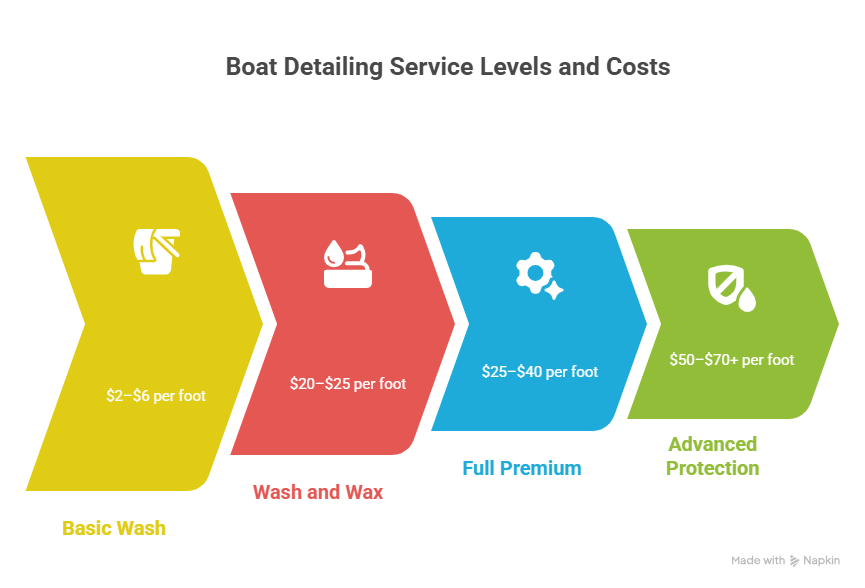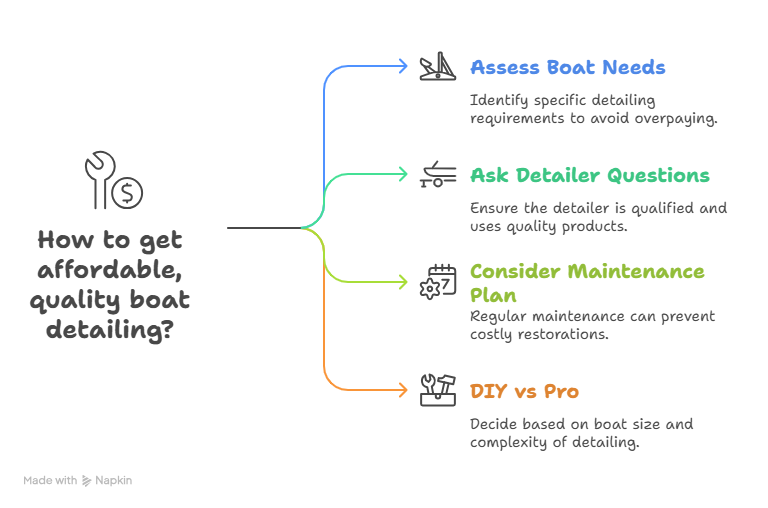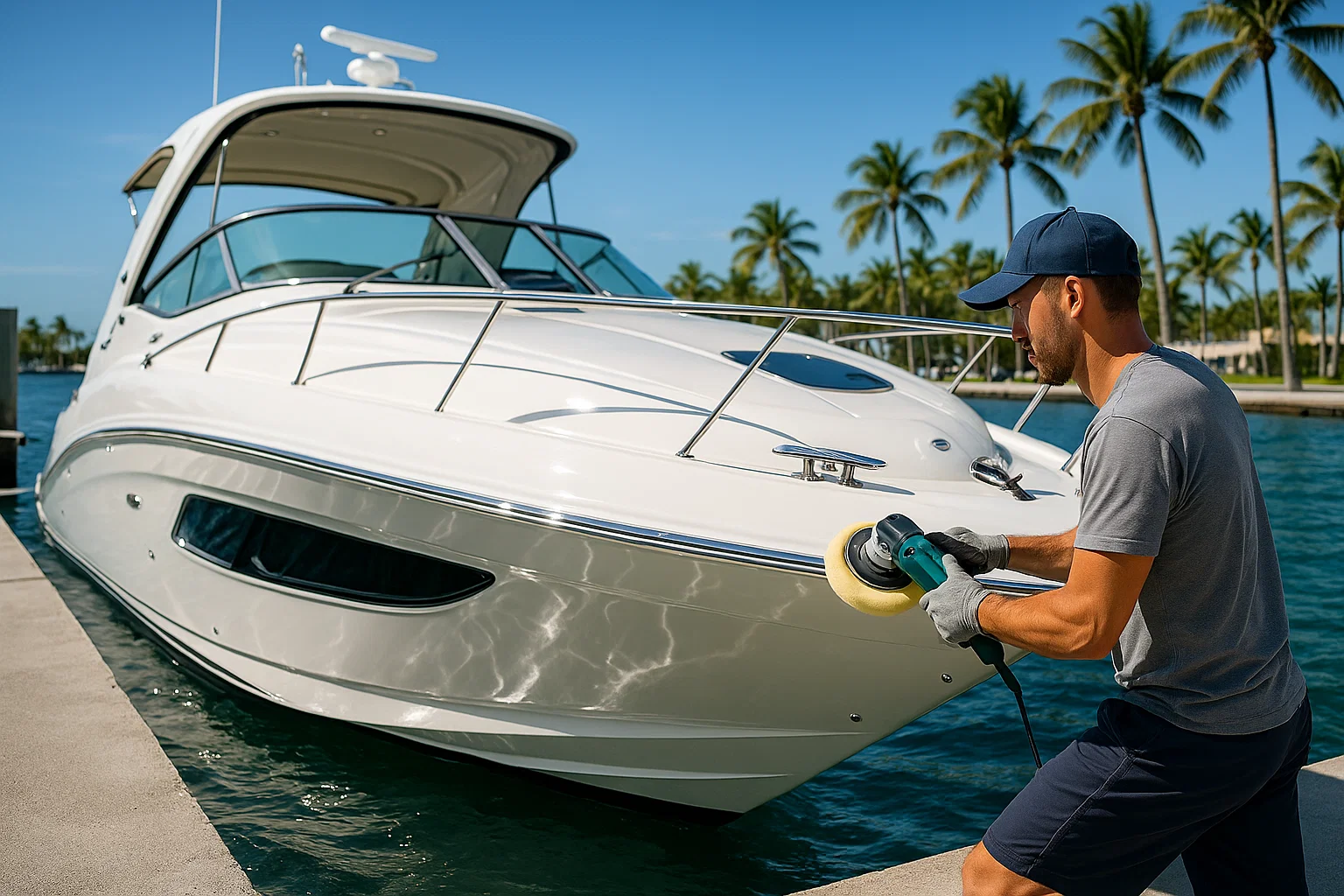Boat Detailing Prices: 15 Years of Wax, Grit, and Lessons Learned
I’ve been detailing boats in South Florida for 15 years, from sleek center consoles in Miami to weathered cruisers at Fort Lauderdale’s Bahia Mar. Last June 2024, a client named Javier rolled his 30-foot Sea Ray 350 into Dinner Key Marina, frustrated after a $1,200 quote from one shop and $600 from another for the same job. Turns out, his gelcoat was chalky as hell—oxidation that needed heavy compounding. I’ve seen this confusion too many times: boat owners blindsided by “per-foot” prices that don’t tell the whole story. Here’s my take on what drives boat detailing prices, how to pick the right service, and how to avoid overpaying while keeping your boat gleaming.
Table of Contents
What’s Behind Boat Detailing Prices?
Boat detailing isn’t just a wash—it’s about protecting your investment from Florida’s brutal sun and salt. Prices vary wildly because every boat’s different, and “per-foot” quotes are just the starting line. I’ll break down the real factors that shape your bill, from oxidation to boat complexity, so you can talk to detailers like a pro.
Why Do “Per-Foot” Prices Vary So Much?
“Per-foot” pricing is the marine industry’s go-to for quick estimates, based on your boat’s length. It’s simple: a 40-foot yacht takes more time and product than a 20-foot skiff. But it’s not the full picture. Last summer, I quoted $20 per foot for a Boston Whaler’s basic wash, but Javier’s Sea Ray needed $40 per foot for compounding—same length, different condition. The per-foot price is a handshake, not the final bill.
What Are Typical Per-Foot Costs by Boat Size?
Here’s what I’ve seen across South Florida marinas for 2024, based on my own jobs and chats with pros at Stiltsville:
| Boat Size | Basic Detail | Comprehensive Detail |
|---|---|---|
| Small (up to 20 ft) | $10–$20/foot | $20–$30/foot |
| Medium (20–40 ft) | $12–$25/foot | $25–$35/foot |
| Large (over 40 ft) | $15–$30/foot | $30–$45+/foot |
These are baselines. A neglected boat or one with a flybridge jacks up the cost. I’ll dig into why next.
How Does Boat Condition Affect the Price?
Your boat’s condition is the biggest cost driver. A clean hull just needs a wash; a chalky one needs hours of compounding. Last July, a client at Key Biscayne brought me a 25-foot Grady-White with heavy oxidation—white powder everywhere. Restoring it took 10 hours of compounding and polishing, pushing the cost to $35 per foot instead of $15 for a basic job. Run your fingernail across your hull: if it’s powdery, brace for a higher quote.
Why Does Boat Type and Complexity Matter?
A simple runabout’s a breeze compared to a sportfisher with towers and cabins. I detailed a 30-foot center console in Coconut Grove last month—four hours, $600. A 30-foot cruiser with a cabin and non-skid decks took eight hours and $1,200. Features like hard tops, teak rails, or bilge compartments add time. Detailers factor this in, so don’t expect the same price for different boats.
How Does Service Scope Impact the Cost?
Detailing’s a menu: exterior, interior, or both. Exterior work covers the hull and topsides—washing, waxing, polishing. Interior means scrubbing vinyl, shampooing carpets, and tackling mildew in the head. A guy at Bahia Mar last spring paid $500 for an exterior-only wash and wax on his 20-foot skiff, but $900 when he added interior cleaning. Pick what your boat needs to keep costs in check.
How Does Location Change Boat Detailing Prices?
South Florida’s a pricey market—high demand, salty air, and steep overhead. I charge $15–$25 per foot for basic details in Miami, but I’ve heard inland lake detailers in Georgia quote $10–$15. Coastal hubs like Fort Lauderdale or West Palm Beach mean higher rates—sometimes 20% more than quieter areas. Check local marina boards for regional norms.
What Are the Main Boat Detailing Service Levels?
Detailers offer tiered services, from quick washes to full restorations. Knowing what’s included helps you choose the right one for your boat and budget. Here’s what I offer, based on 200+ jobs in South Florida.
What’s a Basic Wash & Express Detail?
This is for boats in decent shape needing routine upkeep. It’s a quick wash, non-skid scrub, window wipe-down, and sometimes a light vacuum. I call it the “Season Opener.” Perfect for regular boaters who don’t want grime buildup. Costs $2–$6 per foot for a wash, $10–$20 per foot for an express detail.
What’s a Wash and Wax Service?
This is the go-to for most owners. It’s a deep clean plus marine-grade wax or sealant to shield against UV and salt. I did a wash and wax on a 30-foot Sea Ray last August for $720—$24 per foot. It’s the best value for seasonal protection. Expect $20–$25 per foot.
What’s a Full Premium Detail?
For boats with chalky, faded gelcoat, this is a full restoration. It involves heavy compounding to remove oxidation, polishing for shine, and waxing for protection. I restored a 35-foot cruiser at Coconut Grove in 2023—took 12 hours, cost $1,400 ($40 per foot). Ideal for resale prep or neglected boats. Runs $25–$40 per foot.
What Are Advanced Protection Services?
For top-tier protection, marine ceramic coatings are king. They create a hard, semi-permanent shield that lasts years. I applied one to a 40-foot yacht last April—$2,400 ($60 per foot), but it’s a breeze to clean now. Other add-ons like teak restoration or brightwork polishing can add $5–$20 per foot. Ceramic coatings start at $50–$70+ per foot.

How Can You Get Affordable, Quality Boat Detailing?
Getting a fair deal means knowing your boat and vetting pros. Here’s how I’ve helped clients like Javier save money without skimping on quality.
How Do I Assess My Boat’s Needs?
Before calling a detailer, check your boat. Run your fingernail across the hull—if it’s chalky, you’ve got oxidation, adding $25–$70 per foot for compounding. Look for stains, mildew, or cracked vinyl. I showed a buddy at Dinner Key how to spot oxidation on his Boston Whaler—saved him from a vague $1,500 quote. Use this checklist:
- Chalkiness/Fading: Powdery hull? Needs compounding.
- Stains/Grime: Rust or water lines? Needs extra scrubbing.
- Mildew: Black spots on vinyl or canvas? Requires specialized cleaners.
- Vinyl Condition: Cracked or sticky? May need replacement.
What Questions Should I Ask a Detailer?
Don’t just ask for a price. Last year, a client at Stiltsville avoided a shady detailer by asking these:
- “Are you insured for marine work? Can you show proof?”
- “What marine-grade products do you use for gelcoat and vinyl?”
- “Can you give an itemized quote for each service?”
- “Got photos or references from boats like mine?”
- “What’s your process for removing heavy oxidation?”
Why Is a Maintenance Plan Worth It?
Regular washes prevent costly restorations. I’ve got a monthly plan with a guy at Key Biscayne—$100 per wash for his 20-footer, saving him $500 yearly by avoiding compounding. Many detailers offer discounts for recurring plans—ask about them. It’s cheaper than a $1,000+ restoration.
Should I DIY or Hire a Pro?
DIY’s fine for small boats (under 25 feet) or simple washes if you’ve got time and tools. I taught a client at Bahia Mar to wax his 18-foot skiff—$50 in supplies, done in two hours. But for oxidation, ceramic coatings, or big boats, pros have the gear—like my 3M compounding pads—and expertise. If your weekend’s worth more than $500, call a pro.

FAQ: Common Boat Detailing Price Questions
Why Do Boat Detailing Prices Vary So Much?
It’s all about condition, boat type, and services. A chalky 30-footer needs $1,200 for compounding, while a clean one might be $600 for a wash and wax. I saw this with Javier’s Sea Ray last June—oxidation doubled his quote. Check your hull first to avoid surprises.
How Often Should I Detail My Boat?
I recommend a wash every 4–6 weeks and a wax every 3–6 months in Florida’s sun. A client at Coconut Grove skipped waxing for a year—cost him $1,500 for a full detail. Regular care saves money. Try a local shop with ABYC-certified detailers.
What’s the Cheapest Way to Keep My Boat Clean?
Monthly washes—$2–$6 per foot—are the cheapest way to avoid big restoration bills. I set up a $100/month plan for a 20-footer at Key Biscayne, saving $500 yearly. Ask detailers for recurring discounts to cut costs.
Are Ceramic Coatings Worth the High Cost?
Yes, if you want long-term protection. I applied a $2,400 ceramic coating to a 40-foot yacht last April—cuts cleaning time by 70%. It’s pricier ($50–$70/foot), but lasts years. Check out Gtechniq’s marine products for durability.
How Do I Spot Oxidation Before Calling a Detailer?
Run your fingernail across the hull. Chalky powder means oxidation, adding $25–$70 per foot for compounding. I showed a client at Dinner Key this trick—saved him from a vague $1,500 quote. Inspect first to get accurate quotes.
What Products Should a Detailer Use?
Marine-grade products like 3M compounds, Star brite cleaners, or Gtechniq ceramics are a must. I ditched a detailer in 2022 who used car wax—ruined a client’s gelcoat. Ask for product names and check they’re marine-specific.
Can I Save Money with DIY Detailing?
For small boats, yes. I taught a buddy to wash his 18-foot skiff for $50 in supplies. But for oxidation or ceramics, pros have tools like my 3M polisher. If you DIY, use marine-grade products—check BoatUS for guides.
Conclusion
Boat detailing prices don’t have to be a mystery. After 15 years of scrubbing hulls in Miami, I’ve learned it’s about knowing your boat’s needs and asking the right questions. That chalky gelcoat on Javier’s Sea Ray last June? It doubled his quote, but a quick fingernail test could’ve prepped him for the cost. Here’s what to remember:
- Oxidation’s the big cost driver. Check for chalky powder to know what you’re in for.
- Per-foot’s just a start. Condition, boat type, and services shape the real price.
- Vet pros carefully. Ask about insurance, products, and itemized quotes.
- Regular washes save big. A $100 monthly plan beats a $1,500 restoration.
Walk to your boat, do the fingernail test, and use my checklist. You’ll be ready to get quotes that match your boat’s needs, not just a vague per-foot number. A well-maintained boat’s your ticket to stress-free days on the water—invest in it.
Author Bio
I’m Alex, a 15-year marine detailing pro based in Miami, with ABYC certification and 200+ boats detailed, from skiffs to yachts. I’ve saved clients thousands by teaching them to spot oxidation early and choose the right services.


Leave a Reply